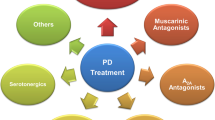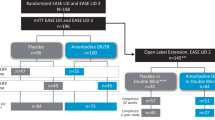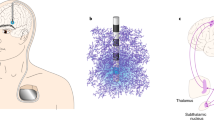Abstract
Continuous dopaminergic stimulation is a therapeutic strategy for the management of Parkinson's disease, which proposes that dopaminergic agents that provide continuous stimulation of striatal dopamine receptors will delay or prevent the onset of levodopa-related motor complications. Dopaminergic neurons in the basal ganglia normally fire in a random but continuous manner, so that striatal dopamine concentrations are maintained at a relatively constant level. In the dopamine-depleted state, however, intermittent oral doses of levodopa induce discontinuous stimulation of striatal dopamine receptors. This pulsatile stimulation leads to molecular and physiologic changes in basal ganglia neurons and the development of motor complications. These effects are reduced or avoided when dopaminergic therapies are delivered in a more continuous and physiologic manner. Studies in primate models and patients with Parkinson's disease have shown that continuous or long-acting dopaminergic agents are associated with a decreased risk of motor complications compared with short-acting dopamine agonists or levodopa formulations. Continuous dopaminergic stimulation can be achieved with a continuous infusion, but infusion therapies are cumbersome and not likely to be acceptable to patients with early disease. The current challenge is to develop a long-acting oral formulation of levodopa that provides comparable anti-parkinsonian benefits without motor complications.
Key Points
-
Levodopa remains the 'gold standard' for Parkinson's disease (PD) therapy, although chronic use of this drug is associated with the development of motor complications
-
Levodopa-induced motor complications can be divided into two main subgroups: motor fluctuations and dyskinesias
-
Continuous dopaminergic stimulation in patients with PD is associated with a reduced risk of motor complications compared with short-acting agents that induce discontinuous or pulsatile stimulation
-
Continuous dopaminergic stimulation might be achieved by continuous intestinal infusion of levodopa, or by modifying the pharmacokinetic profile of the drug by administering it in combination with a catechol-O-methyltransferase inhibitor
-
Long-acting dopamine agonists reduce the risk of motor complications, but they are not as effective as levodopa for treating PD, and levodopa supplementation is eventually needed in patients treated with these drugs
-
The challenge is to develop a long-acting formulation of levodopa that provides anti-parkinsonian benefits while avoiding motor complications
This is a preview of subscription content, access via your institution
Access options
Subscribe to this journal
Receive 12 print issues and online access
$209.00 per year
only $17.42 per issue
Buy this article
- Purchase on Springer Link
- Instant access to full article PDF
Prices may be subject to local taxes which are calculated during checkout




Similar content being viewed by others
References
Olanow CW (2004) The scientific basis for the current treatment of Parkinson's disease. Ann Rev Med 55: 41–60
Marsden CD and Parkes JD (1976) “On–off” effects in patients with Parkinson's disease on chronic levodopa therapy. Lancet 1: 292–295
Fahn S (1992) Adverse effects of levodopa. In The Scientific Basis for the Treatment of Parkinson's Disease, 89–112 (Eds Olanow CW and Lieberman AN) Lancaster: Parthenon Publishing Group
Obeso JA et al. (2000) Levodopa motor complications in Parkinson's disease. Trends Neurosci 23 (Suppl): S2–S7
Lang AP and Lozano AE (1998) Parkinson's disease. New Engl J Med 339: 1044–1053
Walter BL and Vitek JL (2004) Surgical treatment for Parkinson's disease. Lancet Neurol 3: 719–728
Chase TN et al. (1989) Rationale for continuous dopamimetic therapy of Parkinson's disease. Neurology 39: 7–10
Nutt JG et al. (2000) Continuous dopamine-receptor stimulation in advanced Parkinson's disease. Trends Neurosci 23 (Suppl): S109–S116
Olanow WC et al. (2000) Continuous dopamine-receptor stimulation in early Parkinson's disease. Trends Neurosci 23 (Suppl): S117–S126
Grace AA (1991) Phasic versus tonic dopamine release and the modulation of dopamine system responsivity: A hypothesis for the etiology of schizophrenia. Neuroscience 41: 1–24
Grace AA and Bunney BS (1984) The control of firing pattern in nigral dopamine neurons: single spike firing. J Neurosci 4: 2866–2876
Abercrombie ED et al. (1990) Effects of L-DOPA on extracellular dopamine in striatum of normal and 6-hydroxydopamine-treated rats. Brain Res 525: 36–44
Venton BJ et al. (2004) Real-time decoding of dopamine concentrating changes in the caudate-putamen during tonic and phasic firing. J Neurochem 89: 1284–1295
Olanow CW and Obeso JA (2000) Preventing levodopa-induced dyskinesia. Ann Neurol 47: 167–178
Obeso JA et al. (1994) The role of pulsatile versus continuous dopamine receptor stimulation for functional recovery in Parkinson's disease. Eur J Neurosci 6: 889–897
Muenter MD and Tyce GM (1971) L-Dopa therapy of Parkinson's disease: plasma L-dopa concentration, therapeutic response, and side effects. Mayo Clin Proc 46: 231–239
Nutt JG and Holford NHG (1996) The response to levodopa in Parkinson's disease: imposing pharmacologic law and order. Ann Neurol 39: 561–573
Nutt JG (1987) On–off phenomenon: relation to levodopa pharmacokinetics and pharmacodynamics. Ann Neurol 22: 535–540
Fabbrini G et al. (1988) Motor fluctuations in Parkinson's disease: central pathophysiological mechanisms, part I. Ann Neurol 24: 366–371
Fahn S (2000) The spectrum of levodopa-induced dyskinesias. Ann.Neurol 47 (Suppl 1): S2–S11
Barbeau A (1980) High-level levodopa therapy in severely akinetic parkinsonian patients: twelve years later. In Parkinson's Disease: Current Progress, Problems and Management, 229–239 (Eds Rinne U et al.) Amsterdam: Elsevier/North-Holland Biomedical Press
Marsden CD and Parkes JD (1977) Success and problems of long-term levodopa therapy in Parkinson's disease. Lancet 1: 345–349
Golbe LI (1991) Young-onset Parkinson's disease: a clinical review. Neurology 41: 168–173
Quinn N et al. (1987) Young onset Parkinson's disease. Mov Disord 2: 73–91
Schrag A et al. (1998) Young-onset Parkinson's disease revisited—clinical features, natural history, and mortality. Mov Disord 13: 885–894
Schrag A and Quinn N (2000) Dyskinesias and motor fluctuations in Parkinson's disease. A community-based study. Brain 123: 2297–2305
Fahn S et al. (2004) Levodopa and the progression of Parkinson's disease. N Engl J Med 351: 2498–2508
Albin RL et al. (1989) The functional anatomy of basal ganglia disorders. Trends Neurosci 12: 366–375
DeLong MR (1990) Primate models of movement disorders of basal ganglia origin. Trends Neurosci 13: 281–289
Obeso JA et al. (2000) Pathophysiology of the basal ganglia in PD. Trends Neurosci 23: 8–19
Lee FJ et al. (2005) Direct receptor cross-talk can mediate the modulation of excitatory and inhibitory neurotransmission by dopamine. J Mol Neurosci 26: 245–225
West AR and Grace AA (2002) Opposite influences of endogenous dopamine D1 and D2 receptor activation on activity states and electrophysiological properties of striatal neurons: studies combining in vivo intracellular recordings and reverse microdialysis. J Neurosci 22: 294–304
Schultz W (1994) Behavior-related activity of primate dopamine neurons. Rev Neurol (Paris) 150: 634–639
Schultz W (1998) Predictive reward signal of dopamine neurons. J Neurophysiol 80: 1–27
Calabresi P (1993) Electrophysiology of dopamine-denervated striatal neurons; implications for Parkinson's disease. Brain 116: 433–452
Centonze D et al. (1999) Unilateral dopamine denervation blocks cortico-striatal LTP. J Neurophysiol 82: 3575–3579
Raz A et al. (2000) Firing patterns and correlations of spontaneous discharge of pallidal neurons in the normal and the tremulous 1-methyl-4-phenyl-1,2,3,6-tetrahydropyridine vervet model of parkinsonism. J Neurosci 20: 8559–8571
Filion M et al. (1988) Abnormal influences of passive limb movement on the activity of globus pallidus neurons in parkinsonian monkeys. Brain Res 444: 165–176
Nini A et al. (1995) Neurons in the globus pallidus do not show correlated activity in the normal monkey, but phase-locked oscillations appear in the MPTP model of parkinsonism. J Neurophysiol 74: 1800–1805
Miller DW and Abercrombie ED (1999) Role of high-affinity dopamine uptake and impulse activity in the appearance of extracellular dopamine in striatum after administration of exogenous L-dopa: studies in intact and 6-hydroxydopamine-treated rats. J Neurochem 72: 1516–1522
de la Fuente-Fernandez R et al. (2004) Levodopa-induced changes in synaptic dopamine levels increase with progression of Parkinson's disease: implications for dyskinesias. Brain 127: 2747–2754
Tedroff J et al. (1996) Levodopa-induced changes in synaptic dopamine in patients with Parkinson's disease as measured by [11C] raclopride displacement and PET. Neurology 46: 1430–1436
Calon F et al. (1998) Molecular basis of levodopa-induced dyskinesias. Ann Neurol 47: 70–78
Cenci MA et al. (1999) Changes in the regional and compartmental distribution of FosB- and JunB-like immunoreactivity induced in the dopamine-denervated rat striatum by acute or chronic L-dopa treatment. Neuroscience 94: 515–527
Aubert I et al. (2005) Increased D1 dopamine receptor signaling in levodopa-induced dyskinesia. Ann Neurol 57: 17–26
Papa SM et al. (1991) Internal globus pallidus discharge is nearly suppressed during levodopa-induced dyskinesias. Ann Neurol 46: 732–738
Filion M et al. (1991) Effects of dopamine agonists on the spontaneous activity of globus pallidus neurons in monkeys with MPTP-induced parkinsonism. Brain Res 547: 152–161
Heimer G et al. (2002) Dopamine replacement therapy reverses abnormal synchronization of pallidal neurons in the 1-methyl-4-phenyl-1,2,3,6-tetrahydropyridine primate model of parkinsonism. J Neurosci 22: 7850–7855
Picconi B et al. (2003) Loss of bidirectional striatal synaptic plasticity in L-DOPA-induced dyskinesia. Nat Neurosci 6: 501–506
Bedard PJ et al. (1986) Chronic treatment with levodopa, but not bromocriptine induces dyskinesia in MPTP-treated parkinsonian monkeys: correlation with [3H] spiperone binding. Brain Res 379: 294–299
Gomez-Mancilla B and Bedard P (1992) Effect of chronic treatment with (+)-PHNO, a D2 agonist in MPTP-treated monkeys. Exp Neurol 117: 185–188
Blanchet PJ et al. (1996) Dyskinesia and wearing-off following dopamine D1 treatment in drug-naïve 1-methyl-4-phenyl-1,2,3,6-tetrahydropyridine-lesioned primates. Mov Disord 11: 91–114
Pearce RK et al. (1998) De novo administration of ropinirole and bromocriptine induces less dyskinesia than L-dopa in the MPTP-treated marmoset. Mov Disord 13: 234–241
Blanchet PJ et al. (1995) Continuous administration decreases and pulsatile administration increases behavioral sensitivity to a novel dopamine D2-agonist (U-91356A) in MPTP-exposed monkeys. J Pharmacol Exp Ther 272: 854–859
Bibbiani F et al. (2005) Continuous dopaminergic stimulation reduces risk of motor complications in parkinsonian primates. Exp Neurol 192: 73–78
Morissette M et al. (1999) Differential regulation of striatal preproenkephalin and preprotachykinin mRNA levels in MPTP-lesioned monkeys chronically treated with dopamine D1 or D2 receptor agonists. J Neurochem 72: 682–692
Juncos JL et al. (1989) Continuous and intermittent levodopa differentially affect basal ganglia function. Ann Neurol 25: 473–478
Engber TM et al. (1991) Levodopa replacement therapy alters enzyme activities in striatum and neuropeptide content in striatal output regions of 6-hydroxydopamine lesioned rats. Brain Res 552: 113–118
Maratos EC et al. (2003) Both short- and long-acting D-1/D-2 dopamine agonists induce less dyskinesia than L-DOPA in the MPTP-lesioned common marmoset (Callithrix jacchus). Exp Neurol 179: 90–102
Stibe CMN et al. (1988) Subcutaneous apomorphine in parkinsonian on-off oscillations. Lancet 1: 403–406
Gancher ST et al. (1995) Apomorphine infusional therapy in Parkinson's disease: clinical utility and lack of tolerance. Mov Disord 10: 37–43
Katzenschlager R et al. (2005) Continuous subcutaneous apomorphine therapy improves dyskinesias in Parkinson's disease: a prospective study using single-dose challenges. Mov Disord 20: 151–157
Colzi A et al. (1998) Continuous subcutaneous waking day apomorphine in the long term treatment of levodopa induced interdose dyskinesias in Parkinson's disease. J Neurol Neurosurg Psychiatry 64: 573–576
Manson AJ et al. (2002) Apomorphine monotherapy in the treatment of refractory motor complications of Parkinson's disease: long-term follow-up study of 64 patients. Mov Disord 17: 1235–1241
Vaamonde J et al. (1991) Subcutaneous lisuride infusion in Parkinson's Disease: response to chronic administration in 34 patients. Brain 114: 601–614
Kurlan R et al. (1986) Duodenal delivery of levodopa for on–off fluctuations in parkinsonism: preliminary observations. Ann Neurol 20: 262–265
Sage JI et al. (1988) Long-term duodenal infusion of levodopa for motor fluctuations in parkinsonism. Ann Neurol 24: 87–89
Ruggieri S et al. (1989) Jejunal delivery of levodopa methylester. Lancet 2: 45–46
Syed N et al. (1998) Ten years' experience with enteral levodopa infusions for motor fluctuations in Parkinson's disease. Mov Disord 13: 336–338
Stocchi F et al. (2002) Prospective randomized trial of lisuride infusion versus oral levodopa in PD patients. Brain 125: 2058–2066
Rascol O et al. (2000) A five year study of the incidence of dyskinesia in patients with early parkinson's disease who were treated with ropinirole or levodopa. N Engl J Med 342: 1484–1491
Parkinson Study Group (2000) Pramipexole vs levodopa as initial treatment for Parkinson disease. JAMA 284: 231–238
Whone AL et al. (2003) Slower progression of Parkinson's disease with ropinirole versus levodopa: The REAL-PET study. Ann Neurol 54: 93–101
Parkinson Study Group (2002) Dopamine transporter brain imaging to assess the effects of pramipexole vs levodopa on Parkinson disease progression. JAMA 287: 1653–1661
Stocchi F et al. (2005) Infusion of levodopa methyl ester in patients with advanced PD: a clinical and pharmacokinetic study. Arch Neurol 62: 905–910
Koller WC et al. (1999) Immediate-release and controlled-release carbidopa/levodopa in PD: a five year randomized multicenter study. Neurology 22: 1012–1019
Nutt JG et al. (1994) Effect of peripheral catechol-O-methyltransferase inhibition on the pharmacokinetcs and pharmacodynamics of levodopa in parkinsonian patients. Neurology 44: 913–919
Kurth MC et al. (1997) Tolcapone improves motor function and reduces levodopa requirement in patients with Parkinson's disease experiencing motor fluctuations: a multicenter, double-blind, randomized, placebo-controlled trial. Neurology 48: 81–87
Parkinson Study Group (1997) Entacapone improved motor fluctuations in levodopa-treated Parkinson's disease patients. Ann Neurol 42: 747–755
Olanow CW and Stocchi F (2004) COMT inhibitors in Parkinson's disease: can they prevent and/or reverse levodopa-induced motor complications? Neurology 62 (Suppl 1): S72–S81
Smith LA et al. (2005) Multiple small doses of levodopa plus entacapone produces continuous dopaminergic stimulation and reduces dyskinesia induction in MPTP-treated drug naïve primates. Mov Disord 20: 306–314
Smith LA et al. (2003) Effect of pulsatile administration of levodopa on dyskinesia induction in drug-naive MPTP-treated common marmosets: effect of dose, frequency of administration, and brain exposure. Mov Disord 18: 487–495
Olanow CW et al. (2001) An algorithm (decision tree) for the management of Parkinson's disease (2001): treatment guidelines. Neurology 56 (Suppl 5): S1–S88
The Parkinson Study Group (2003) A controlled trial of rotigotine monotherapy in early Parkinson's disease. Arch Neurol 60: 1721–1728
Woitalla D et al. (2004) Transdermal lisuride delivery in the treatment of Parkinson's disease. J Neural Transm Suppl 68: S89–S95
Nilsson D et al. (1998) Long term intraduodenal infusion of a water based levodopa carbidopa dispersion in very advanced Parkinson's disease. Acta Neurol Scand 97: 175–183
Stocchi F et al. (1996) Fluctuating parkinsonism: a pilot study of single afternoon dose of levodopa methyl ester. J Neurol 243: 377–380
Asin KE and Wirtshafter D (1993) Effects of repeated dopamine D1 receptor stimulation on rotation and c-fos expression. Eur J Pharmacol 235: 167–168
Smith LA et al. (2002) The actions of a D-1 agonist in MPTP treated primates show dependence on both D-1 and D-2 receptor function and tolerance on repeated administration. J Neural Transm 109: 123–140
Gancher ST et al. (1996) Apomorphine tolerance in Parkinson's disease: lack of a dose effect. Clin Neuropharmacol 19: 59–64
Brotchie JM (2005) Nondopaminergic mechanisms in levodopa-induced dyskinesia. Mov Disord 20: 919–931
Author information
Authors and Affiliations
Corresponding author
Ethics declarations
Competing interests
CW Olanow has served as a consultant for Boehringer Ingleheim, Novartis/Orion, Schwarz, Solvay, Teva and Valeant. He has no stock in any of these companies. JA Obeso declared associations with Boeringher Ingleheim, GlaxoSmithKline, Newron, Novartis/Orion, Pfizer, Teva and Vernalis. F Stocchi serves as a consultant for Novartis, Newron, Teva and Vernalis, and has received honoraria from Boehringer, GlaxoSmithKline, Orion and Pfizer. JA Obeso is on the scientific board of GlaxoSmithKline and Novartis, and and has received honoraria for lecturing in meetings sponsored by Boeringher, GlaxoSmithKline, Novartis/Orion and Schwarz.
Rights and permissions
About this article
Cite this article
Olanow, C., Obeso, J. & Stocchi, F. Drug Insight: continuous dopaminergic stimulation in the treatment of Parkinson's disease. Nat Rev Neurol 2, 382–392 (2006). https://doi.org/10.1038/ncpneuro0222
Received:
Accepted:
Issue Date:
DOI: https://doi.org/10.1038/ncpneuro0222
This article is cited by
-
A metabolomics study in aqueous humor discloses altered arginine metabolism in Parkinson’s disease
Fluids and Barriers of the CNS (2023)
-
Should continuous dopaminergic stimulation be a standard of care in advanced Parkinson’s disease?
Journal of Neural Transmission (2023)
-
Continuous dopaminergic stimulation counteracts l-DOPA-induced overactivity of Ca2+ in 6-OHDA-lesioned rats
Experimental Brain Research (2022)
-
Psychometric Properties of Clinical Indicators for Identification and Management of Advanced Parkinson’s Disease: Real-World Evidence From G7 Countries
Neurology and Therapy (2022)
-
The impact of tube replacement timing during LCIG therapy on PEG-J associated adverse events: a retrospective multicenter observational study
BMC Neurology (2021)



